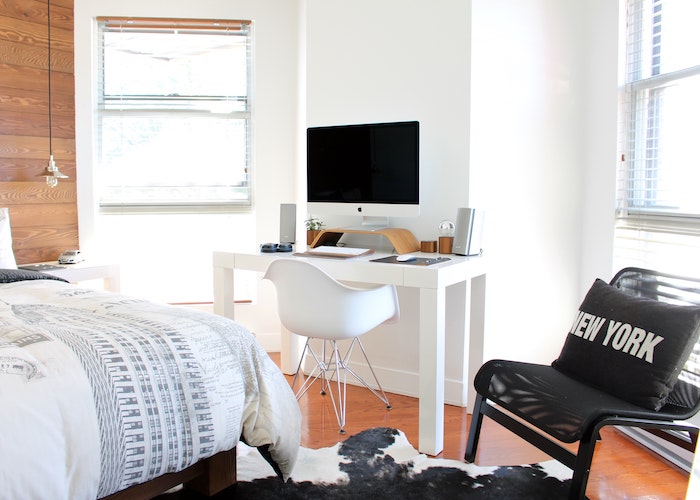How I Revised My Budget & Debt Plan When Buying A Home

This article is sponsored by CreditRepair.com.
About four years ago, my husband and I decided to officially make it a goal to own a house. Which is basically the stuff of myth when you live in Los Angeles and don’t have a trust fund. But the year before, the startup I was working for got acquired, and the equity I had in it materialized into a decent chunk of cash overnight. It wasn’t enough money for a downpayment for a house (in Southern California, that is), but it was enough to motivate us and make us feel like a home we could actually own was within reach. So, for four years we lived below our means, saved, and paid close attention to the real estate market.
The first time we applied to be pre-approved for a loan was about two years ago. We treated it like a test run, because we honestly didn’t know what we were doing. I sent our loan officer about a five-foot stack of financial documents, including three months of bank statements, proof of income, and an application to get our credit scores checked. My credit came back in the dark green range, but my husband’s hovered in the lower light green — which is technically good, but I wondered why his credit wasn’t better. I knew that he paid his bills on time (we shared a bank account, so I could see the automatic monthly payments coming out), and I didn’t think he was secretly buying cars behind my back (he definitely wasn’t, we didn’t even have a dedicated parking spot for our two cars).
It turned out he still had $20,000 in debt, which shocked us both. “How…did this happen?” I said slowly, after reading the numbers in an email. He wasn’t sure. He had a few credit cards he used fairly casually, but he didn’t think he was using them that frequently. After a few calls to his lenders and spending some time printing out statements over the last couple years, we found nothing nefarious — he’d just been using his credit card for things like gas, groceries, Target trips, and other purchases that could have easily gone on a debit card. If it had, we would have been able to better track our budget and know where we stood instead of getting totally blindsided in the middle of house-hunting.
Pro tip: Another option is using CreditRepair.com’s services to stay on top of your credit score so that you’re always in the know — and knowledge is power.
The $20k debt wasn’t doing us any favors in a competitive market, and we needed a plan of attack. And by plan of attack, I mean paying it off quickly. We immediately took $15k out of savings (that was meant to go toward our down payment) and paid at least most of the debt off. The other $5k remaining would be paid off in six months. I had a plan.
1. My husband and I would only use our credit cards strategically.
I felt like I was already doing this. I had a Discover card with a low APR, Target and Amazon cards I paid off every month, and a few store cards I only used when there was a sale. After completely paying off a couple cards, my husband took the remaining balance of one card and transferred it to a new account with a 0% APR for six months — that would save us a sizable amount of money we’d otherwise be spending on interest alone. If you’re unsure how to find credit cards with 0% APRs, Nerd Wallet compiled the best 0% APR and low-interest cards as of September 2020.
Pro tip: If you’re still unsure of what exactly affects your credit score, CreditRepair.com helps you stay on top of it. Their team of experts provides you a hands-off way to address your credit by working with credit bureaus directly.
2. We cut back frivolous expenses like takeout, nights out at bars, and shopping.
Back then, both of us had high-paying jobs, our rent was relatively low, and we didn’t have kids to take care of on top of everything — so this was by no means “crisis mode.” But it was important that we came up with not only the $15k we spent to pay off the debt, but the $5k we still needed to bring our collective debt to zero. This meant no takeout, expensive drinks at bars, no just-for-fun trips at Target, and going through all subscriptions we had that we could easily put on pause for a while. In sum, we were extra careful about our spending and watched our transaction like two takeout sushi-deprived hawks.
3. I started freelancing on the side again for some extra cash.
After getting my first staff job back in 2015, I put my freelance career on ice. But when it became clear that we could really benefit from even an extra $500-$1,000 coming in every month, I made it a mission to work nights and some weekends to make that happen. And it added up, quickly! (Although always, always remember to put money away for taxes at the end of the year.)
4. I tracked every single purchase we made.
I know, I know. We should have been always doing this. But I always figured I was being responsible by checking our online checking account regularly. As it turns out, that’s only part of it. I created a chart similar to the one TFD published, and included all of our combined expenses and payments. The problem we ran into was not thoroughly tracking what we were spending on and what card we (fine, my husband) were using to make those purchases. Credit cards can be such a useful, smart tool — but not if you use them without a rhyme or reason. A survey from the U.S. News and World Report showed more than 21 percent of Americans didn’t even know if they had debt.
In May of 2019, we were in a better place. We had paid off a large chunk of credit card debt, agreed to a tighter budget, and had some extra monthly income flowing in. We put an offer into a cute little yellow house in a small LA neighborhood, about $20k under asking price, because some areas of the house clearly needed some remodeling and updating. That offer was declined (we later found out that the buyer whose offer was accepted backed out of the deal after the house was inspected — turns out, the foundation needed something like $30k in work on its own). A month later, we found a sweet little Spanish-style house in East LA and put another offer in, and it was accepted.
With our debt significantly paid off, we started using our credit cards again for things like repairs, and new furniture for a backyard we never had before. But this time, we set clear boundaries and rules for ourselves. The soonest we could pay off our debts, the better. If we could use our remaining savings for large purchases, we would.
While the home-buying experience seems never-ending (you will be asked for bank statements and tax returns and your head of HR’s number multiple times, and you’ll be emailing your loan officer and real estate agent at midnight over the smallest discrepancies and questions) it was worth it. Not only did we finally have a home of our own, but we now feel more in control of finances than ever.
If you’re thinking of making a major purchase like a home, improving your credit score is one of the most important steps to help you make sure you get the interest rate you deserve. CreditRepair.com can help you navigate your credit score ahead of time, making you feel super in control of your finances. If you’re unhappy with your credit score, Credit Repair can look into questionable negative items, making sure your evaluation is fair and accurate, ask your creditors to verify the negative items they’re reporting, and continuously monitor your credit so that you can reach your financial goals.
Image via Unsplash
Like this story? Follow The Financial Diet on Facebook, Instagram, and Twitter for daily tips and inspiration, and sign up for our email newsletter here.




